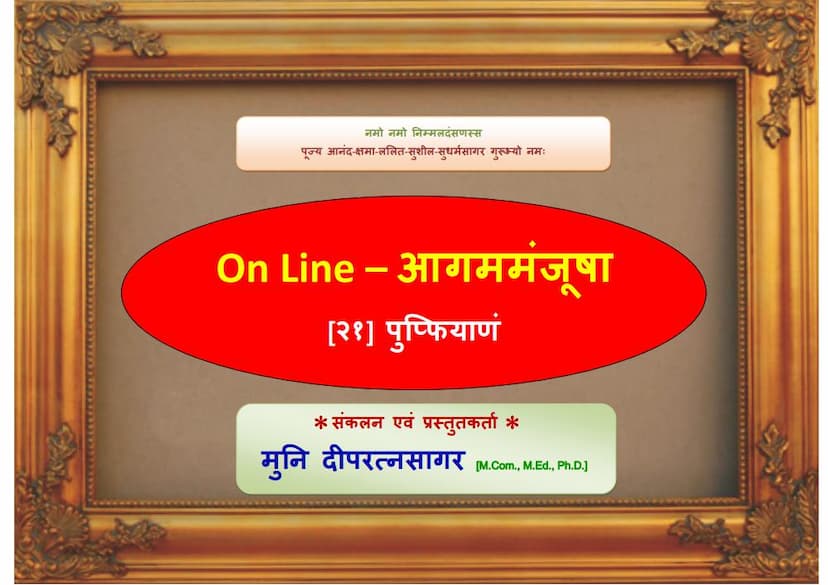Aagam Manjusha 21 Uvangsuttam Mool 10 Pupfiya
Added to library: September 1, 2025

Summary
This summary of the Jain text "Aagam Manjusha 21 Uvangsuttam Mool 10 Pupfiya" is based on the provided pages and aims to capture the essence of its content, particularly the "Pupfiya" section.
Overview:
The text is presented as the "Online-Aagam Manjusha," a digital reissue of a work originally compiled 70 years prior in 1942 by Acharya Anand Sagar Suri. This 2012 digital version, compiled by Muni Deepratnasagar, aims to make the ancient Jain Agamas accessible online. The compiler notes some minor variations from the original compilation, such as the inclusion of commentaries (Niyukti, Bhashya) alongside the core texts and the inclusion of "Kalpa (Barsa) Sutra" and "Pindaniyukti" as alternatives.
Focus on "Pupfiya" (Chapter 21):
The core of the provided text focuses on the "Pupfiya" chapter, which is part of the Upanga section of the Jain Agamas. This chapter is presented as having ten sections (Adhyayanas). The text delves into specific narratives and teachings related to past lives (Purva Bhava), celestial beings, and exemplary individuals who achieved spiritual progress.
Key Narratives and Themes:
The text recounts various life stories that illustrate Jain principles. While the specific details are extensive and often follow a repetitive structure common in Agamic texts, the recurring themes include:
- The Lives of Celestial Beings: Several sections describe the existence and activities of celestial beings (Devas) and their abodes in various heavens. Examples include the Sun (Surya), Moon (Chandra), and other celestial luminaries. Their lifespan, powers, and eventual rebirths in the human realm are described.
- Stories of Exemplary Individuals: The text details the lives of individuals who, through their actions and adherence to Jain dharma, achieved significant spiritual progress or were reborn in celestial realms. These narratives often highlight:
- Past Deeds (Karma): The consequences of past actions (karma) are emphasized, showing how good deeds lead to favorable rebirths and how attachment to worldly pleasures can hinder spiritual advancement.
- Renunciation and Asceticism: Many stories feature individuals who, after experiencing worldly life, embrace asceticism (Saman, Anagar) and undertake severe penance (Tapas) to purify their souls and attain liberation (Siddhi).
- The Role of Teachers (Gurus/Arhats): The teachings and guidance of Arhats and enlightened beings are crucial in these narratives, leading individuals towards the right path.
- The Path to Liberation: The ultimate goal is liberation from the cycle of birth and death. The stories illustrate the steps involved, including righteous conduct, devotion, understanding of dharma, and the eradication of karma.
- Specific Examples of Narratives:
- Chandro Jyotiraja (Moon, Lord of Lights): This section describes the life and rebirth of the Moon, highlighting its celestial status and its eventual rebirth in a human lineage.
- Suryo Jyotiraja (Sun, Lord of Lights): Similar to the Moon, the Sun's journey and rebirth are depicted.
- Shukra Mahamagraha (Venus, the Great Planet): The life and rebirth of Venus are detailed.
- Bahupuniyā Devi (Devi Bahupuniyā): This narrative describes a celestial being who, after performing her duties in the heavens, is destined for a specific human birth and subsequent spiritual progression.
- Somā (later called Subhadrā): This extensive narrative details the life of a woman who, after enduring the hardships of motherhood and family life, embraces Jain monasticism and strives for liberation. This story emphasizes the transition from worldly attachment to spiritual dedication and the importance of following the teachings of enlightened nuns.
- Puṇyabhadrā (Deva Puṇyabhadrā) and Māṇibhadra (Deva Māṇibhadra): These sections describe celestial beings and their eventual rebirths as lay disciples who practice Jain dharma and strive for spiritual progress, eventually leading to liberation.
Key Jain Concepts Illustrated:
The "Pupfiya" chapter, as presented here, vividly illustrates several fundamental Jain concepts:
- Karmic Theory: The intricate workings of karma and its impact on rebirths are central to the narratives.
- The Cycle of Birth and Death (Samsara): The stories follow individuals through multiple lifetimes, emphasizing the continuous cycle of existence.
- Spiritual Progression: The text highlights the journey from ignorance to knowledge, from worldly attachment to renunciation, and from the mundane to the spiritual.
- Ahimsa (Non-violence): While not explicitly detailed in this summary, the underlying principles of Jainism, which are rooted in Ahimsa, are implicitly present in the pursuit of righteous living and liberation.
- The Importance of Right Faith, Knowledge, and Conduct (Samya'k Darshan, Samya'k Gyan, Samya'k Charitra): The stories showcase individuals who, by embracing these three jewels, achieve spiritual advancement.
Publisher and Compiler Information:
The publication details confirm that this is a reissue of a classic work, emphasizing its continued relevance and accessibility through digital means. The efforts of Muni Deepratnasagar in bringing this ancient text to a modern platform are highlighted.
In essence, "Aagam Manjusha 21 Uvangsuttam Mool 10 Pupfiya" serves as a collection of edifying stories and teachings from Jain tradition, providing insights into the consequences of actions, the path to spiritual enlightenment, and the lives of those who have strived for liberation across different lifetimes and realms. The "Pupfiya" chapter, in particular, offers detailed accounts of celestial beings and exemplary human lives as a means to impart spiritual wisdom.